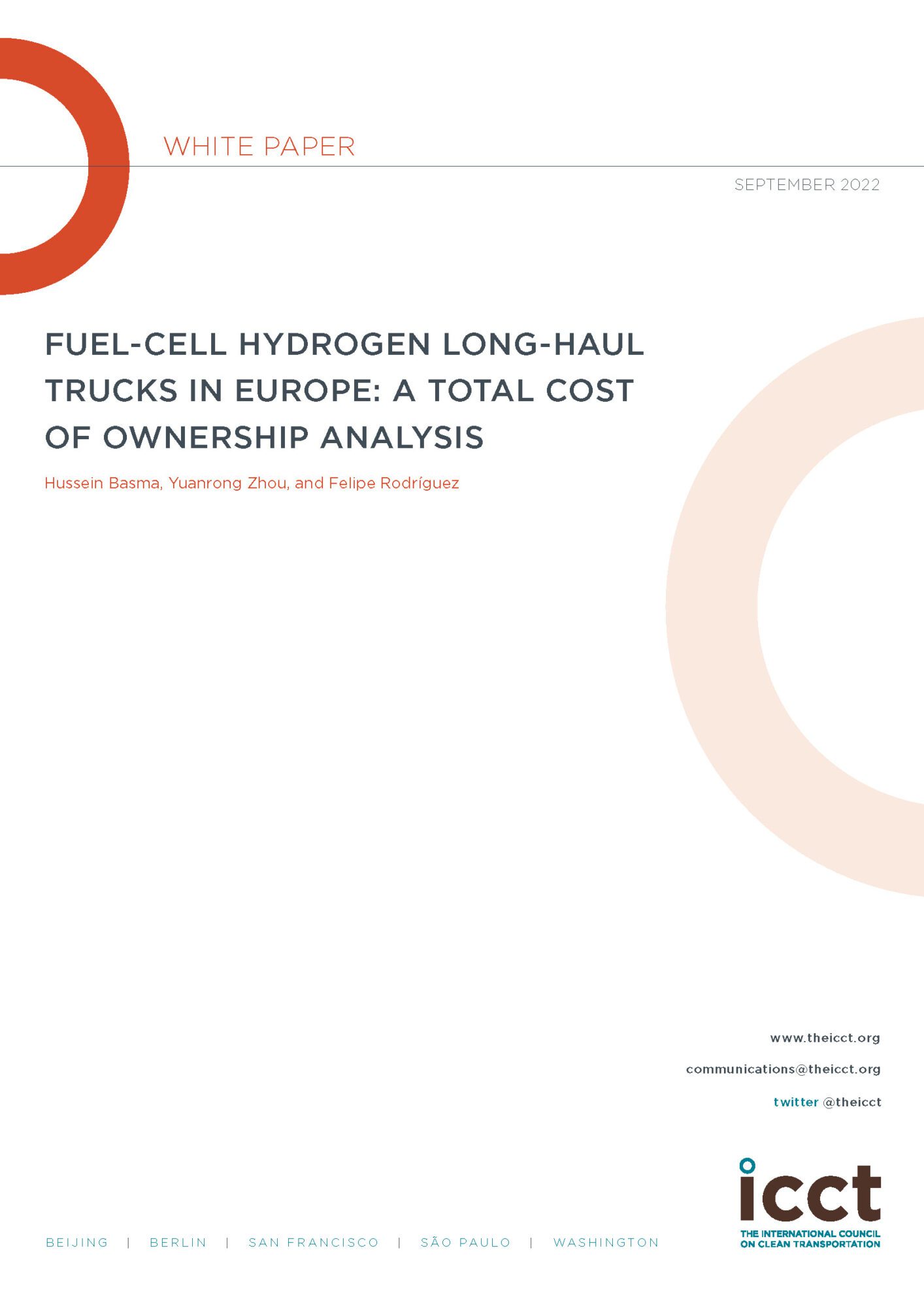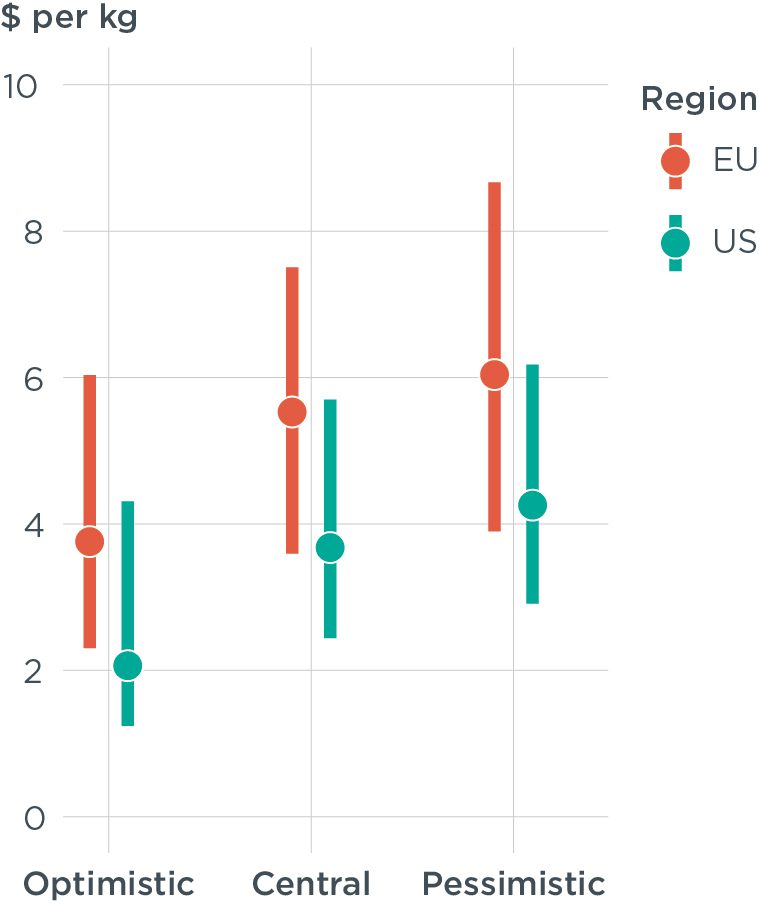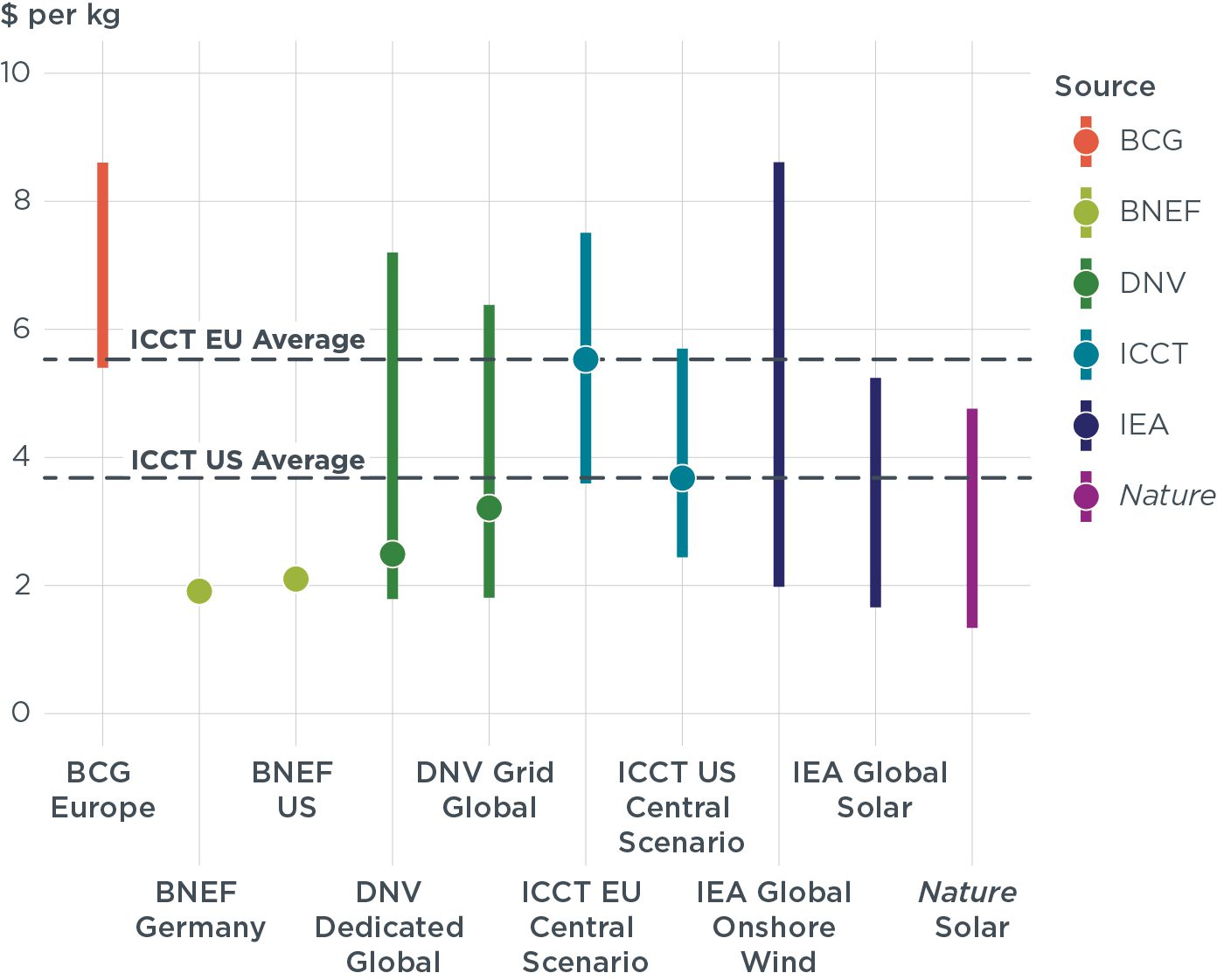Blog
The price of green hydrogen: How and why we estimate future production costs
The ongoing debate about the future of hydrogen as a fuel to help decarbonize transportation and other sectors is driven in part by uncertainties about cost. “Green” hydrogen, made through renewable-energy-powered electrolysis, is being promoted globally; however, few green hydrogen plants are currently operating and real-world cost data is scarce. This means policymakers must rely on cost projections to understand when and where hydrogen might make sense as a low-carbon solution and which policies could enable its use.
But how are green hydrogen costs projected, and why do projections from various groups differ so widely? Luckily, the basics behind these questions are easy enough to understand. To foster transparency in the debate , let’s explore the key assumptions behind the ICCT’s projections for hydrogen cost in the United States and Europe and see how our projections compare with other estimates.
Electricity, electrolyzers, and capital
Across the literature, three key factors are used to estimate green hydrogen production costs. Projections include assumptions about each of these factors which are then combined to reach levelized production costs. For this the ICCT uses a discounted cash flow (DCF) analysis and we project optimistic, central, and pessimistic scenarios.
1. The cost of electricity to hydrogen producers. Because green hydrogen requires electricity generated from renewable resources, we have to understand the future cost of renewables to build a well-founded estimate. To analyze wind and solar costs, the ICCT uses data from the National Renewable Energy Laboratory’s (NREL) annual technology baseline (ATB), which provides a publicly accessible assessment of current renewable installation costs and estimates of future costs under different technology-improvement scenarios.
Our central cost scenario, which represents what we see as the mostly likely outcome, is based on the cost of renewables in the “moderate” ATB scenario. Under this scenario, “Innovations observed in today’s market become more widespread, and innovations that are nearly market-ready today come into the market.” We combine this with regional data from the United States and countrywide data from European Union (EU) Member States on solar and wind capacity factors to estimate levelized wind and solar production costs in any given year. To estimate future electricity costs in other countries, we adjust installation costs and capacity factors to reflect present-day local conditions; we assume technology will improve at the same rate for all regions, thanks to global supply chains.
When sourcing renewable electricity, hydrogen producers must also decide whether to install a directly connected renewable system or acquire renewable electricity supplied via the grid using a power purchase agreement (PPA). A direct, “behind-the-meter” connection avoids transmission and distribution (T&D) fees, but the electricity is only available when the sun shines or the wind blows. That’s generally 20%–35% of the time for solar and 30%–50% for onshore wind; these percentages are known as capacity factors. In practice, a direct connection means producers will run fewer hours and end up producing less hydrogen than they would if they ran the same electrolyzer for more hours using grid-supplied electricity. Conversely, the T&D fees when purchasing renewable electricity via a PPA over the grid can more than double what a producer pays on a dollar-per-MWh basis.
To estimate regional hydrogen production cost, our model assumes producers will choose the more cost-effective electricity option in any region. For example, in our central scenario for 2030 in the United States, it would be cheaper to use dedicated renewables via a direct connection in 74% of modeled regions. Meanwhile, in Europe, it would be more cost effective to purchase renewable electricity supplied over the grid in 26 out of the 27 Member States. Additional uncertainties about future improvements in wind and solar technologies are incorporated into our “optimistic” and “pessimistic” forecasts. Overall, the combined impacts of renewable technology assumptions, regional capacity factors, and the application of T&D fees for grid supplied renewables lead to a broad range of possible electricity costs for hydrogen producers in our forecasts. These varying renewable electricity costs are responsible in part for the range of outcomes in published green hydrogen cost forecasts.
To date, our published green hydrogen cost forecasts, including those here, assume hydrogen producers can claim the use of any renewable electricity supplied in the same year as hydrogen production (known as annual matching). In 2023, the European Union released a Delegated Regulation with rules for how to define green hydrogen and its derivatives (called renewable fuels of non-biological origin) that included hourly matching requirements for grid-connected PPAs starting in 2030. Likewise, the proposed regulations for the Inflation Reduction Act 45V hydrogen tax credits in the United States would require hourly matching in 2028. Hourly matching requirements are critical for ensuring green hydrogen production does not increase fossil fuel consumption by drawing power from the grid at times of low renewable electricity production. For this reason, we will investigate potentially incorporating the impact of hourly matching requirements on electricity cost in future ICCT cost analyses. A recent study modeled that it might impact hydrogen prices by $1 per kg or less in the United States.
2. The cost and capabilities of electrolyzers. The upfront cost of purchasing and installing an electrolyzer is another key driver of hydrogen cost. Our assumptions about alkaline, proton exchange membrane, and solid oxide electrolyzer performance and future improvements are based on a comprehensive 2019 study published in Nature Energy. As with renewables, we project optimistic, central, and pessimistic scenarios that represent different technology improvement rates. For example, our central scenario estimates alkaline electrolyzer costs will decline from $1,163 per kW in 2020 to $634 per kW in 2050 with a corresponding efficiency improvement of hydrogen output energy from 70% of electrical input energy in 2020 to 80% in 2050. Estimates of future electrolyzer costs from different groups vary widely, contributing to the different forecast outcomes. Again taking alkaline electrolyzer installed costs as an example, 2050 estimates from different groups range from $100 per kW under an optimistic scenario to a possible $1,200 per kW on the upper end, illustrating just how much uncertainty there is about the cost of core green hydrogen components.
3. The cost of capital. Building a large-scale green hydrogen facility requires hundreds of millions of dollars. To raise this money, we assume project developers will use a mix of equity financing, where investors take partial ownership of a project and expect a return on investment, and debt financing, where developers take out loans with defined payback periods and interest rates. Giving equity investors a return on their investment and paying back loans both add to the overall costs of hydrogen production. The ICCT uses available information on the cost of capital to commercial-scale renewables projects and adjusts it upward to reflect the additional offtake and technology risks associated with green hydrogen projects compared to renewables.
Putting these three factors together, Figure 1 shows the ICCT’s estimates for hydrogen costs across U.S. regions and European Union Member States in 2030 under different technology-improvement scenarios. Our estimates assume producers will choose the renewable energy source (wind or solar), connection type (direct or grid), and electrolyzer type (alkaline, proton-exchange membrane, or solid oxide) that’s most cost effective for that region. Note, though, that these factors only determine green hydrogen production costs; “at the pump” prices paid by consumers, which include the cost of compression, transportation, and distribution, will be much higher.
Figure 2 shows the ICCT’s central technology case alongside other recent cost estimates from the literature for comparison. The ICCT’s central estimates of 2030 hydrogen production costs of $3.7 per kg in the United States and $5.6 per kg in the European Union fall within the range in the literature.
Even though it’s only a few years away, there’s still a range of possibilities for the cost of green hydrogen in 2030. While we know with certainty that the cost of hydrogen will be a product of the three factors outlined above, where costs will land in the future can’t be known with certainty. Other questions that will influence future costs include 1) How will hourly matching requirements for sourcing renewable electricity for hydrogen production in proposed Inflation Reduction Act guidance and in EU regulations affect a hydrogen producer’s ability to use round-the-clock renewable electricity when connected to the grid? 2) Will electrolyzers be able to ramp up and down with renewable production, as required in a “direct connection” scenario? and 3) Will green hydrogen demand scale quickly enough to achieve predicted learning rates?
Answers to these questions will help determine whether hydrogen can become a cost-effective decarbonization solution across different sectors. In the meantime, it’s important to bring as much transparency as possible to the process of projecting future costs.
Authors
Related Publications

FUEL-CELL HYDROGEN LONG-HAUL TRUCKS IN EUROPE: A TOTAL COST OF OWNERSHIP ANALYSIS
Evaluates the total cost of ownership of fuel cell electric trucks in seven European countries.



